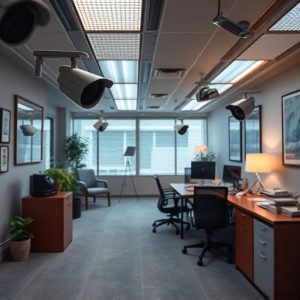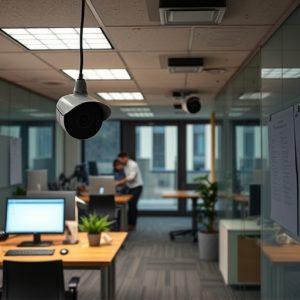Office Security Spotlight: Understanding Hidden Cameras’ Role & Implications
Office hidden cameras are a modern surveillance tool used in workplaces to protect assets, secure s…….
Office hidden cameras are a modern surveillance tool used in workplaces to protect assets, secure sensitive information, and deter theft, fraud, and intellectual property breaches. These cameras are designed to be inconspicuous, blending into the office environment while providing high-definition footage for security purposes. Employers must place them strategically to balance coverage with the natural flow of the office, and they must comply with legal regulations regarding video surveillance in the workplace. When used thoughtfully and ethically, hidden cameras can effectively safeguard business interests and maintain a secure environment without overtly intruding on privacy. It's crucial for employers to adhere to surveillance laws by notifying employees of the recording devices and ensuring their use is justified and aligned with legitimate security needs. Regular maintenance, updates, and evaluations of the camera system are necessary to keep it functional and effective in protecting the workplace.
In the contemporary workplace, the integration of surveillance systems has become a topic of significant discussion. Office hidden cameras, often discreetly placed, play a pivotal role in safeguarding business interests and assets. This article delves into the nuances of hidden office security cameras, exploring their presence, function, and the myriad legal and ethical considerations they entail. From the types of cameras used to best practices for their placement and monitoring, understanding these elements is crucial for balancing privacy with protection in professional settings. Key insights will guide businesses in navigating this complex landscape responsibly and effectively.
Unveiling the Presence of Hidden Office Security Cameras: A Closer Look
Office hidden cameras have become an increasingly integral component of modern surveillance systems, providing a discreet means to monitor activities within the workplace. These cameras, skillfully concealed among everyday office objects or strategically placed where least expected, offer a dual advantage: safeguarding assets against theft and ensuring the security of sensitive information. With advancements in technology, these devices are now smaller, more versatile, and capable of recording high-quality footage that can be reviewed at any time. Employers often install such cameras to protect intellectual property, deter fraudulent activities, and maintain a secure environment for both employees and proprietary data. The strategic placement of office hidden cameras is crucial for effective coverage; they are typically positioned in areas where high-value assets or critical operations occur, ensuring comprehensive surveillance without overt disruption to the workspace’s ambiance. Understanding the legal implications and privacy concerns associated with their use is paramount, as it varies by jurisdiction. It is essential for businesses to comply with applicable laws and regulations regarding video surveillance in the workplace. With the right balance of transparency and covertness, hidden office cameras can serve as a silent guardian, safeguarding against unforeseen incidents and maintaining the integrity of business operations.
The Role and Types of Hidden Cameras in Office Surveillance
Office hidden cameras play a pivotal role in safeguarding sensitive information, monitoring workplace activity, and deterring potential theft or vandalism. These discreet surveillance tools are strategically placed to ensure that they are unobtrusive yet comprehensive in their coverage. The types of hidden cameras used in offices can vary from tiny dome cameras, which blend seamlessly into the ceiling, to covertly designed bullet cameras that mimic everyday objects like smoke detectors or light fixture components. Advanced models may feature high-definition resolution and infrared capabilities for optimal performance during all lighting conditions. Additionally, some hidden cameras are equipped with motion detection technology, alerting security personnel only when activity is detected, thus conserving storage space and reducing the volume of footage to review. The strategic placement of these cameras is crucial; they are often installed at entrances/exits, in common areas, around sensitive data areas, and at points where valuable equipment or confidential discussions occur. This ensures that both employees and visitors are aware that their activities within the office space are being monitored, thereby fostering a secure and professional environment.
Legal and Ethical Considerations When Implementing Hidden Office Cameras
The deployment of hidden office cameras necessitates a careful balance between security needs and individual privacy rights. Legally, organizations must comply with surveillance laws, which vary by jurisdiction but generally require notification to employees about monitoring activities. These laws dictate that signs should be conspicuously placed in areas where recording occurs, informing individuals of the surveillance. Ethically, employers have a responsibility to respect the privacy and dignity of their staff. The use of such cameras must be justified by a legitimate purpose, such as protecting sensitive information or detecting unlawful activities. Employers should conduct a thorough assessment of the risks versus benefits, ensuring that the cameras are only used in a manner consistent with maintaining a trustworthy environment. It is crucial to consider the context in which these cameras operate; they should not be employed as tools for micro-managing or spying on employees in private areas. By adhering to legal requirements and upholding ethical standards, businesses can responsibly utilize hidden office cameras to enhance security while safeguarding the rights of their personnel. Keyword inclusion: hidden office cameras, office surveillance laws, privacy rights, ethical considerations in surveillance, legal compliance for office camera use.
Best Practices for Discreet Camera Placement and Monitoring in Offices
When integrating hidden office security cameras, strategic placement is paramount to effectively monitor critical areas while maintaining a discreet presence. Cameras should be positioned at vantage points that offer clear visibility of entry and exit points, high-traffic corridors, and sensitive workspaces without drawing attention to themselves. This minimizes the risk of their discovery, which could compromise security efforts. Additionally, ensuring that the cameras are equipped with motion or sound activation triggers can enhance monitoring efficiency, as they will only record when movement or noise occurs, thus conserving storage space and focusing on significant events.
To further safeguard privacy and compliance with legal surveillance standards, it is crucial to inform employees about the presence of cameras in common areas. Transparency in this regard not only respects individual rights but also reduces the potential for misuse of the camera system. Regular maintenance and software updates are also essential to maintain the integrity and functionality of the hidden cameras. Regularly reviewing the camera network’s coverage and making adjustments as necessary ensures that blind spots are eliminated, and all office areas under surveillance remain secure. Office hidden cameras, when properly deployed, provide a powerful deterrent against theft, vandalism, and other security threats while preserving the professional ambiance of the workplace.


